Exploring Voles' Impact on Lawn Ecosystems
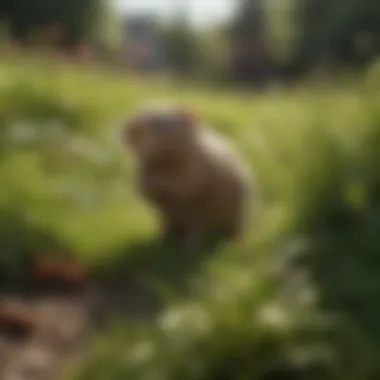
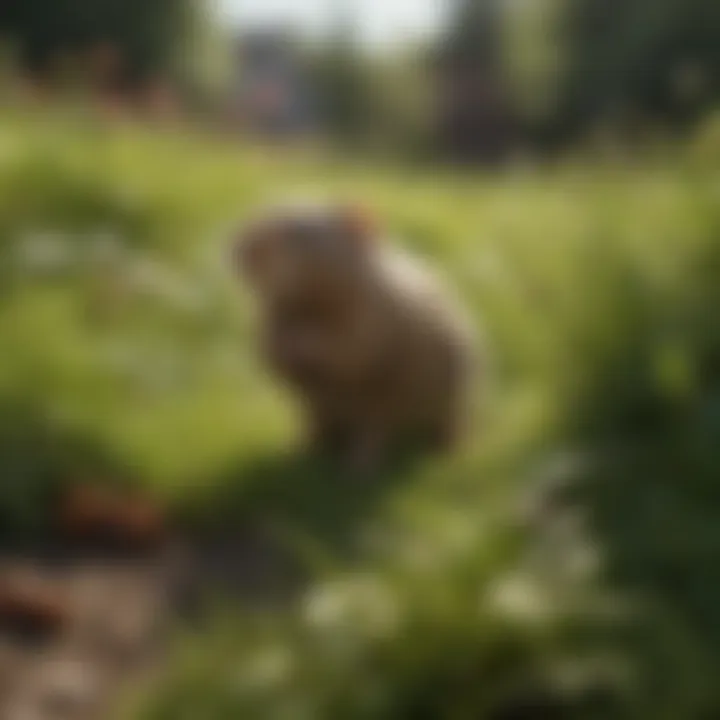
Preventive Pest Control Strategies
When it comes to keeping your lawn intact, preventing pest issues before they arise is crucial. It not only protects your plants and grass but also helps ensure a harmonious living space for you and any wildlife that may call your yard home. Here’s how to formulate a plan that encompasses different aspects of your environment.
House Exterior Protection
Protecting your home starts from the outside, and this is where your pest prevention journey ought to begin.
Tips for sealing cracks
Taking a stroll around your home, you may stumble upon tiny gaps and cracks. These holes can be highways for critters. Ensure that areas around windows, doors, and foundations are all sealed properly. Use caulk to fill in those gaps, ensuring no space is left wide enough for a mouse to wiggle through.
Clearing debris
Having a clutter-free peripheral area can hinder pest habitation. Make it a habit to remove any debris, such as leaves or broken branches. These can serve as perfect hideouts for unwelcome guests. Besides, a tidy yard is always an attractive one.
Preventing pests from entering
Installing door sweeps can stop critters from sneaking inside as you open the door. Consider adding mesh to vents and exhaust fans, too. Keeping a lookout during home inspections can help spot any potential entry points.
Yard Maintenance
A well-maintained yard speaks volumes about pest control. Regular upkeep not only enhances curb appeal but also drastically reduces pest chances.
Essential yard care routines
Regular mowing and trimming can help maintain your lawn health. Taller grass can provide cover, which pests love to utilize as a refuge. Keeping your grass low and plants pruned can help in reducing pest infestations.
Methods for keeping yard pest-free
Planting certain herbs like lavender or mint can deter common pests naturally. Make sure to rotate flowering plants as well; this disrupts pest life cycles and encourages healthy predator populations.
Indoor Cleanliness
Creating a sanctuary from pests indoors is just as important as outdoor upkeep.
Expert cleaning tips and techniques
Vacuuming regularly can help pick up crumbs and debris that serve as food for pests. Consider focusing on the kitchen and dining areas, where tiny morsels tend to escape your gaze. Keeping food items sealed and stored correctly can prevent many critters from feasting.
Maintaining a pest-resistant indoor environment
Denial of access is often the best form of defense. Ensure that garbage cans are lidded and conduct regular checks to keep them clean. As mundane as it sounds, a little indoor tidiness goes far.
Garbage Disposal
Garbage disposal is another crucial aspect to consider.
Efficient waste disposal methods
Keeping your bins clean and using tightly sealed bags can help eliminate alluring scents attracting pests. Rotating the location of your garbage bins periodically can also work wonders.
Importance of proper garbage disposal
It's essential to dispose of food waste promptly. Leaving it sitting can create a mini banquet for various pests. Regular checks ensure that nothing is left to fester and attract unwanted visitors.
Other Pest Prevention Strategies
Beyond the basics, consider these innovative solutions to create a pest-free environment.
- Wildlife-friendly barriers: Install fencing designed to deter certain rodent species without harming them.
- Companion planting: Certain plants can repel pests while boosting the growth of their companions.
- Habitat creation for beneficial species: Designing your yard for birds and beneficial insects can help keep pest numbers down.
"Adjusting your environment doesn’t merely repel unwanted guests; it fosters a thriving habitat."
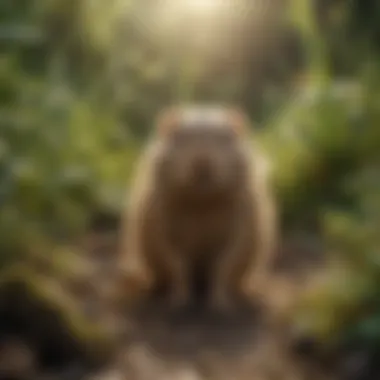
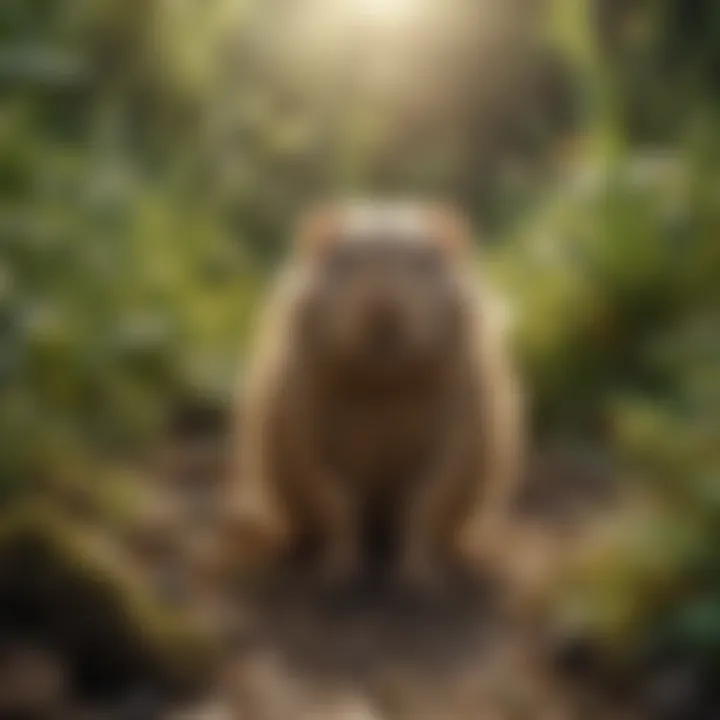
By putting these preventive strategies in place, you can create a well-balanced ecosystem in your lawn, where voles and other wildlife can coexist without causing a mess. This proactive approach sets the foundation for understanding how voles engage with your green space.
The Ecology of Voles in Urban Settings
Understanding the ecology of voles in urban environments offers insight into their significant, albeit often overlooked, role in landscaping and the wider ecosystem. Voles, small rodents closely related to mice and rats, inhabit a variety of environments, yet their presence in urban lawns reveals much about local ecological dynamics. Homeowners might view them as nuisances, but appreciating the broader context in which voles operate sheds light on their ecological importance and potential benefits for garden health.
Defining Voles and Their Habitat
Voles are small, burrowing rodents belonging to the family Cricetidae. Typically characterized by their stocky bodies, short tails, and robust heads, they are adept at navigating through grassy terrains and underground tunnels. Their habitat generally comprises grasslands, meadows, and urban gardens, where they thrive in lush, verdant surroundings. In the landscape of urban settings, these areas often become home to voles due to abundant plant life and opportunities for shelter.
In terms of their preferences, voles are creatures of habit. They seek out environments rich in grasses, sedges, and forbs, as these plants serve as essential food sources. Emerging from their burrows, they graze on grass and roots, while also creating intricate networks of tunnels just below the surface. This burrowing behavior not only gives voles a safe haven from predators but also impacts soil stability and composition.
Vole Species Commonly Found in Lawns
There are several species of voles, but the most common in urban lawns are the Meadow Vole and the Pine Vole. Each species carries its own distinctive habits and ecological roles.
- Meadow Vole (Microtus pennsylvanicus): These voles prefer open fields and grassy environments. They have a tendency to be more active during the day, especially after rainfall, making them easier to spot. Their diet mainly consists of grass, seeds, and the occasional root.
- Pine Vole (Microtus pinetorum): Unlike their meadow counterparts, Pine Voles are mostly nocturnal and prefer wooded areas or dense shrub cover. They often stay underground, making them less significant in visible lawn damage but still influential in soil aeration and nutrient cycling.
It's worth noting that each species' presence brings a unique set of interactions with their environment, including those with plants and potential predators. Understanding these species can aid homeowners in identifying which type might be present in their lawns, thus allowing for better management and appreciation of their ecological role.
"Voles, while often seen as lawn pests, play a critical role in promoting plant health and maintaining soil vitality."
Vole Behavior and Lifestyle
Understanding the behavior and lifestyle of voles is essential for anyone curious about how these small mammals interact within lawn ecosystems. Voles are often seen as nuisances due to their burrowing habits and the damage they can cause to gardens and plant life. However, their behavioral patterns also play a significant role in the overall health of ecosystems, especially in urban settings.
Feeding Habits and Diet
Voles primarily feast on grasses, herbs, and roots, making them herbivores by nature. Their diet showcases a preference for tender shoots and young plant growth, essential for their survival. During warmer months, voles can be found munching on a variety of plants, including clover and dandelions, while in winter, they tend to rely on stored food and roots buried beneath the snow. Notably, voles have been observed to engage in behaviors such as selective grazing, where they target specific plants over others. This behavior can shape plant diversity in lawns, illustrating how voles contribute to the complex tapestry of urban vegetation.
- Seasonal Changes: In the spring, they are active and reproduce quickly, leading to population booms. During the fall, they gather and store food, preparing for harsher winter months.
- Nutritional Needs: The plant matter provides crucial nutrients, but they also consume their feces to recycle nutrients, a practice known as coprophagy. This habit aids in maximizing the absorption of nutrients from food.
"Voles play a pivotal role by acting as ecological engineers, influencing plant community structures while feeding, and are important prey for many urban predators."
Reproduction and Social Structures
Vole reproduction is remarkably prolific. Female voles typically give birth to multiple litters in a year, with each litter containing up to ten offspring. This rapid reproduction rate can lead to spikes in vole populations, sometimes outpacing the ability of predators to keep numbers in check. Voles are generally monogamous, forming pairs that mate for life, which is a noteworthy trait in the rodent world.
In terms of social structure, voles tend to be quite social, living in colonies that can vary in size. Their homes are usually a network of burrows, which protects them from predators and harsh weather. Here are some factors that define their social habits:
- Territory: Male voles may establish territories marked by scent, though they often allow their mates to roam freely.
- Hierarchy: Within colonies, there can be a pecking order, but generally, they exhibit cooperative behaviors, especially during the breeding season.
Understanding these aspects of vole behavior not only sheds light on their ecological role but also helps homeowners appreciate the complexity of their lawns. Instead of viewing voles merely as pests, recognizing their contributions to biodiversity can facilitate a more balanced interaction with nature in urban environments.
Impact of Voles on Lawns
Understanding the impact of voles on lawns is crucial for homeowners and gardeners striving for lush, green spaces. These small rodents often evoke mixed feelings; on one hand, they contribute positively to the garden ecosystem, while on the other hand, they can cause serious damage to plant life and soil health. Grasping the various effects voles have on lawns helps homeowners to implement effective management strategies, ensuring the balance between biodiversity and yard aesthetics.
Effects on Grass and Plant Life
When it comes to lawns, voles undoubtedly leave their mark—sometimes beneficial, often at a cost. These critters are known to munch on a variety of grasses and plants, particularly when other food sources are scarce. For instance, the common meadow vole primarily feeds on grasses, clover, and dandelions, potentially leading to noticeable patches of brown or bald spots on a lawn. Not only do they snack on the above-ground parts, but they also tunnel underground, severing roots and disrupting the overall growth of plants.
"Understanding how voles interact with grass is essential for maintaining a healthy lawn. "
The consumption of grass by voles can lead to stress for the affected plants. In cases of heavy infestation, the balance of your garden may tilt unfavorably, resulting in poor growth or even death of certain grass types. This phenomenon often poses a dilemma for homeowners: the desire for a beautiful yard might conflict with the need to foster a thriving ecosystem.
To mitigate this, one might consider the following points:
- Identify Vole Activity: Keep an eye out for signs of tunneling or burrowing. Signs of voles typically include small burrows or shallow runways in the grass.
- Diversity in Planting: Integrating diverse plant species may reduce risk since voles tend to prefer certain varieties over others.
- Regular Lawn Maintenance: A dense, healthy lawn can better withstand vole activity.
Soil Aeration and Nutrient Cycling
While it’s easy to focus solely on the damage voles cause, we should not overlook their more subtle contributions to soil health as well. Their burrowing activities result in a natural form of soil aeration—think of it as a personal workout for your lawn. By creating tunnels underground, voles help to break up compacted soil, allowing air, water, and nutrients to reach plant roots more effectively.
This natural aeration promotes a richer microbial community in the soil, which is vital for healthy plant growth. When these small rodents dig and forage, they also contribute to nutrient cycling. They often leave behind organic matter, such as uneaten plant material and manure. This organic matter enriches the soil, providing a nutrient boost to surrounding plants.
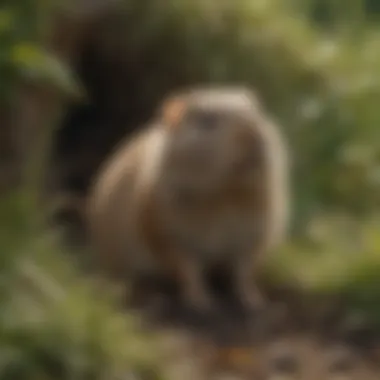
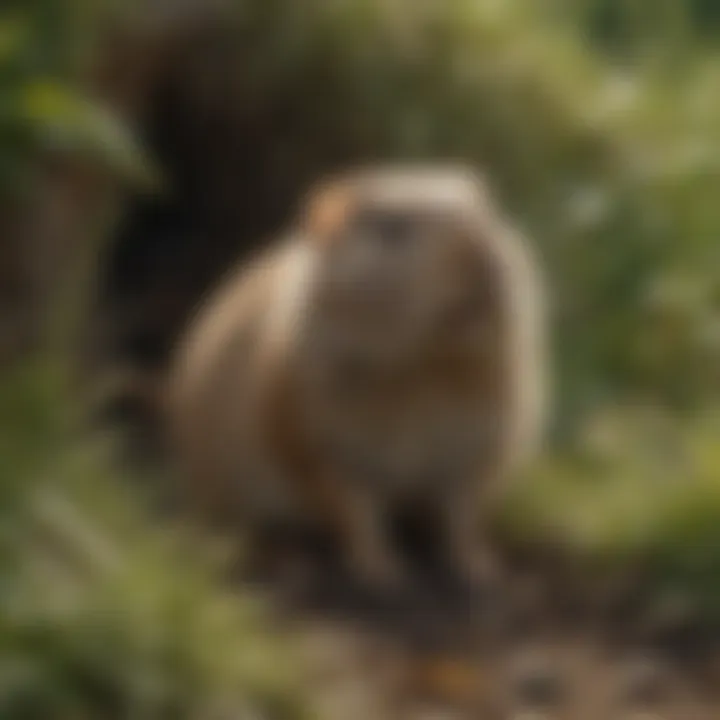
The resulting effects can lead to:
- Enhanced Soil Structure: By aiding in aeration, voles can improve overall drainage in the lawn.
- Increased Nutrient Availability: Their activities facilitate the breakdown of organic matter, which can release essential nutrients back into the soil.
- Promoted Plant Growth: Healthier soil fosters the kind of growth gardeners dream of.
Voles in the Food Web
Voles play an essential role in the food web, acting both as prey and contributing to the ecological balance within urban ecosystems. Understanding their position helps illuminate the interconnected relationships between various organisms, and it emphasizes the significance of maintaining biodiversity. Voles are not just solitary creatures munching on grass; they are entwined with the lives of many animals, facilitating a dynamic web of life that sustains the environment.
Predators of Voles
A variety of predators have made the vole their favorite snack, forming a crucial part of their survival strategy. The presence of owls, hawks, snakes, and even foxes ensures that the vole population remains in check. Here are some key details about these predators:
- Owls: Nocturnal hunters like the great horned owl are specialized in catching voles under the cover of darkness, using their acute hearing to locate them.
- Hawks: Red-tailed hawks, known for their sharp eyesight, swoop down from above to catch unsuspecting voles on the ground.
- Snakes: Many species of snakes, including garter and gopher snakes, hunt voles and regulate their populations effectively.
- Foxes: These cunning predators often hunt voles during the dusk or dawn hours, taking advantage of the low light conditions.
"In the grand play of nature, voles fulfill their part not just by existing but by feeding the myriad of species that depend on them for sustenance."
The interdependence between voles and their predators showcases an ancient survival strategy. This circulatory pattern of life is what keeps the lawn ecosystems vibrant.
Role as Prey in Urban Ecosystems
As prey, voles serve as a food source for creatures at various levels in the food chain, which facilitates significant ecological benefits. Their role is multifaceted:
- Nutrient Transfer: When predators consume voles, they effectively transport nutrients back into the ecosystem through their waste. This process enriches the soil and contributes to plant growth, enhancing the overall landscape.
- Biodiversity Support: By providing sustenance for a range of predators, voles contribute to the diversity of species in urban areas. This variety helps to create a more balanced ecosystem, offering resilience against diseases and changes in environmental conditions.
- Ecosystem Indicators: The health and population dynamics of voles can indicate the overall well-being of the environment. A robust vole population suggests a healthy food web, while declining numbers may signal underlying issues needing attention.
In urban settings, where landscaping can often disrupt natural habitats, appreciating voles can give home and garden owners a better understanding of their outdoor ecosystems. By fostering a respect for these creatures, one can appreciate the hidden connections that sustain the vibrant life around lawns.
Human-Vole Interaction
The interaction between humans and voles can significantly shape local ecosystems, particularly in urban settings. These small rodents, often overlooked, play pivotal roles in our lawns and gardens. Understanding how they affect and are affected by human activities is essential for fostering a balanced environment.
Encounters with Homeowners
Homeowners may find themselves in direct contact with voles, typically during the warmer months when lawn maintenance is at its peak. Most encounters happen unexpectedly; one may notice peculiar trails running through grass, or perhaps curious nibbling marks on the edges of plants. These signs hint at the presence of voles but can sometimes lead to frustration for homeowners who value pristine yards.
Such encounters often bring about a blend of curiosity and concern. While some see voles as merely harmless, others view them as pests that could ruin their carefully curated landscapes. This dual perspective requires a nuanced understanding of these rodents. Instead of knee-jerk reactions, homeowners might benefit from recognizing the ecological balance voles help maintain, including soil aeration and nutrient cycling.
Managing Vole Populations Ethically
Addressing issues with voles in gardens shouldn't prioritize destruction. Instead, homeowners should adopt ethical management practices that respect both their property and the local ecosystem. Here are several strategies:
- Creating Barriers: Fences or netting around exposed gardens offer protection from vole damage while allowing their natural foraging habits to continue in less sensitive areas.
- Plant Selection: Opting for foliage that is less appealing to voles can deter them from munching on valuable plants. Native species often hold up better against local wildlife.
- Natural Predators: Encouraging the presence of natural predators like hawks and owls can help keep the vole population in check. This might involve installing perches or birdhouses that attract these birds.
Homeowners can also benefit from learning the signs of vole activity and recognizing that some level of interaction is actually beneficial for lawns.
"Balancing human interests with wildlife needs is vital for sustainable landscaping and biodiversity."
Practices that blend consideration for wildlife with landscaping goals can lead to more harmonious interactions. Ethical approaches often foster a more diverse ecosystem. Such practices don't just resolve conflicts; they create spaces where voles and humans coexist, benefiting both parties.
By employing thoughtful management techniques, homeowners can maintain the integrity of their green spaces while respecting the role voles play in our gardens. This not only helps in preserving the beauty of lawns but also nurtures biodiversity, ultimately enhancing the urban landscape.
Mitigating Lawn Damage from Voles
Managing the presence of voles in lawns is crucial for homeowners striving to maintain the beauty and health of their green spaces. While these small rodents are a natural component of the ecosystem, their habits can lead to significant damage, especially in manicured lawns. Understanding how to mitigate this damage not only helps protect your lawn but also promotes a balanced coexistence with wildlife.
Being proactive about managing vole populations ensures your landscaping remains vibrant and resilient. Through targeted preventive measures and effective control strategies, homeowners can navigate the challenges that voles present while preserving the ecological integrity of their lawns.
The conversation around mitigating lawn damage extends beyond mere aesthetics. It’s also about fostering a healthy environment where both flora and fauna can thrive in harmony. By adopting specific landscaping techniques and control methods, one can minimize conflict between urban wildlife and personal property, thus enhancing the overall health of the ecosystem.
Preventive Landscaping Techniques
Implementing preventive landscaping techniques can significantly reduce the potential damage caused by voles. Here are a few strategies to consider:
- Choosing the Right Plants: Opt for plants that are less appealing to voles. Perennials with strong aromatic qualities or toxic components, such as lavender or daffodils, can deter these critters quite effectively.
- Creating Barriers: Applying materials like wire mesh or hardware cloth around the base of vulnerable plants can act as a physical barrier against voles. Be sure to bury the mesh at least six inches underground to prevent burrowing.
- Maintaining Lawn Cleanliness: Keeping the lawn clear of debris, tall grass, and other scraps can help minimize habitat for voles. Regular mowing and removing fallen fruit or nuts will reduce their food sources and nesting areas.
- Planting Height Considerations: Placing your garden plants in elevated beds can also make it harder for voles to access them. They prefer to stay close to the ground, so height can be a powerful deterrent.
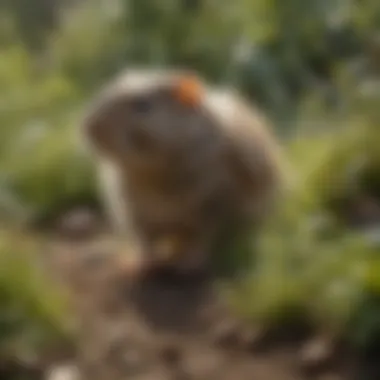
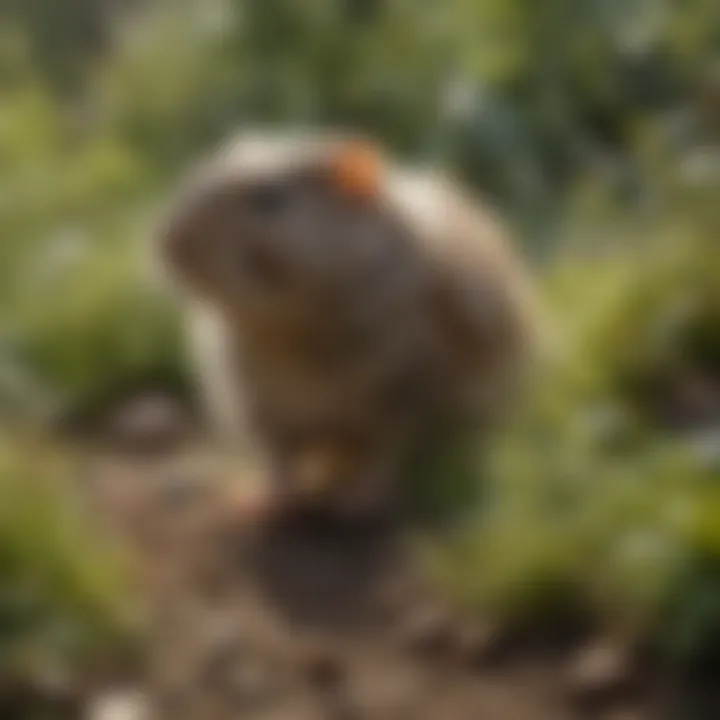
Even small changes in land management can yield substantial benefits regarding vole presence. The goal here isn’t just to eliminate them, but to alter the environment so that they choose to go elsewhere.
Effective Control Methods
Sometimes, despite all preventive measures, voles may still pose a threat. In such instances, effective control methods become essential to protect your lawn. Below are some approaches that homeowners can employ:
- Habitat Alteration: Reducing cover and food sources in your yard can force voles to relocate. Consider altering landscaping features to expose their runs or nests, making the environment less hospitable.
- Trapping: Live traps can be used to capture voles humanely. Placement is key; situate traps in areas where you notice activity, like runways or holes. Always check traps frequently to prevent undue stress on captured animals.
- Predator Attraction: Introduce natural predators to your lawn. Encouraging owls, hawks, or other raptors to nest nearby can help control vole populations naturally. Installing owl boxes or perches may entice these predators to frequent your area.
- Repellents: You might also explore commercial repellents that contain natural ingredients, such as castor oil or peppermint oil. Spraying these around your garden can deter voles without causing harm to the ecosystem.
It's essential for homeowners to remember that controlling voles is not about extermination, but about finding a sustainable balance that allows for both lawn health and the integrity of urban wildlife habitats.
By employing a combination of preventive landscaping techniques and effective control methods, homeowners can significantly mitigate the impact of voles in their lawns. The result is a lawn that is not only beautiful but also respects the natural rhythms of the ecosystem.
The Vole's Contribution to Biodiversity
Voles play a surprisingly intricate role in the broader tapestry of biodiversity within lawn ecosystems. These small rodents, often overlooked in our quest for perfection in landscaping, contribute significantly to the ecological balance. By understanding their contribution, homeowners can appreciate how even the smallest creatures influence the health of gardens and lawns.
Encouraging a Diverse Ecosystem
When we think about biodiversity, the focus often leans toward large and charismatic species. However, the role of voles cannot be overlooked. Here are some key elements of their influence:
- Soil Health: Voles, in their constant search for food, burrow through the soil. This action not only aerates the ground but also helps break down organic matter, enriching the soil. The more aerated the soil, the better it is for root development of grasses and other plants.
- Nutrient Cycling: Voles have a varied diet that includes grasses, seeds, roots, and even some insects. As they consume and excrete waste in the process, they naturally help recycle nutrients. Fecal matter from voles can act as a natural fertilizer, boosting the nutrient profile of the soil.
- Food Source for Predators: Voles are a staple food source for various predators, including owls, hawks, and snakes. By providing sustenance for these animals, voles help maintain predator populations, which can control other pest species in the ecosystem.
- Seed Dispersal: While foraging, voles often transport seeds away from their original location. This incidental seed dispersal can encourage plant diversity, allowing different species of flora to establish themselves in various areas of a lawn.
The complex interactions between voles and their environment demonstrate that these little critters are anything but insignificant. Essentially, they are like the unsung heroes in your garden, working tirelessly to keep it healthy and thriving.
"Voles may be small, but the impact they have on the ecological balance in lawn ecosystems is significant. Their contributions go far beyond mere nuisance."
Homeowners should consider these ecological benefits before rushing to eliminate vole populations. Instead of seeing them as mere pests, it may be wiser to recognize their role in nurturing a healthy organic ecosystem. It’s about balancing our expectations with nature's incredible design, ensuring that we can enjoy our green spaces while maintaining the diversity necessary for resilience in our environment.
Legal and Ethical Considerations
Addressing the legal and ethical considerations surrounding voles in lawn ecosystems is not just a formality; it's a necessary aspect of fostering a responsible approach to wildlife management. Understanding the rules that guard these small rodents alongside ethical responsibilities can encourage more harmonious interactions between human habitats and nature. With these critters playing their essential, albeit sometimes disruptive, roles, knowing how to navigate this landscape can mean the difference between a flourishing ecosystem and human-wildlife conflict.
Protecting Wildlife Legislation
Wildlife protection laws are designed to ensure the prosperity of various species, including voles. In many regions, local legislation is in place to shield these animals from harm and unethical treatment. The Endangered Species Act and various state-level protections may impact vole populations, especially in areas where their numbers are dwindling due to habitat loss or encroachment.
For homeowners, it’s crucial to be aware that certain traps or poisons may not only harm voles but could also violate wildlife protection statutes if not used in compliance with regulations. Here are a few points to consider:
- Familiarity with Local Laws: Residents should familiarize themselves with local wildlife protection laws to ensure their management strategies align with legal parameters.
- Avoiding Harmful Practices: Using inhumane traps or illegal poisons can have dire consequences, both for the wildlife and the person using them.
- Conservation Efforts: Participating in local wildlife conservation programs can aid voles and other species, providing a balanced advantage in urban settings.
"Understanding the laws that protect voles not only secures their future, but also reflects a commitment to ethical wildlife stewardship in our communities."
Ethical Treatment of Urban Wildlife
Beyond legal compliance, another layer emerges: the ethical responsibility towards voles as urban wildlife. While they are often viewed through the lens of property damage or as nuisances, it is vital to appreciate their role in the garden ecosystem.
Here’s what to keep in mind:
- Respecting Natural Habitats: It’s essential not to destroy vole habitats unnecessarily. Instead, look for solutions that allow their presence while mitigating damage. This could mean implementing protective landscaping or enhancing the soil's structure without heavy-duty interventions.
- Non-lethal Methods: Opting for non-lethal methods to manage vole populations, like habitat modification or using deterrents, reflects a greater commitment to ethical treatment without resorting to lethal traps or chemicals.
- Education and Awareness: Engaging in community awareness programs can foster empathy and understanding toward voles at large. A well-informed community is more likely to adopt practices that are beneficial for both voles and their environments.
Renowned ecologist, Dr. Jane Goodall, once stated, "What you do makes a difference, and you have to decide what kind of difference you want to make."
In this light, the effort to understand and ethically manage vole populations can significantly influence urban ecosystems, paving the way to balance ornamental gardens with a thriving wildlife presence.
Future Research and Study Directions
Gaps in Current Knowledge
Although voles have been studied to an extent, there are some notable gaps that researchers need to address. For instance, the specific impact of different vole species on various types of grass could benefit from more detailed exploration. It is currently unclear how species variations affect vegetation in distinct conditions.
- Vole Behavior Variability: How does behavior change according to the urban environment?
- Nutrient Cycling: What role do voles play in soil health and organic matter breakdown that has yet to be quantified?
- Effects of Land Use: How do changing land use practices, such as urban expansion, alter vole populations?
By tackling these questions, future studies can consolidate existing research and produce more actionable insights.
Potential Areas for Ecological Study
Investigating voles offers a rich tapestry of potential areas for ecological research that can enhance our knowledge base significantly. Here are some promising directions:
- Interactions with Other Species: Examining how voles coexist or compete with other small mammals in urban settings could shed light on adaptive behaviors.
- Impact of Climate Change: Assessing how shifting climate patterns affect vole populations and their ecosystems inside urban environments would provide valuable forecasts for biodiversity.
- Role in Biodiversity: A thorough investigation into how voles contribute to urban flora and fauna diversity can yield insights for residential landscaping practices.
- Innovative Management Strategies: Researching humane and effective strategies for managing voles without compromising ecological balance could benefit homeowners significantly.
"A comprehensive understanding of voles and their role in the ecosystem promotes a harmonious relationship between home landscapes and wildlife, paving the way for future urban wildlife management."
Future research into these aspects promises to enhance community knowledge, leading to informed decisions that nurture both lawns and local wildlife. Such studies not only contribute to science but also empower homeowners. Understanding these ecological dynamics enables better choices regarding lawn care practices, thereby enriching our green spaces.



